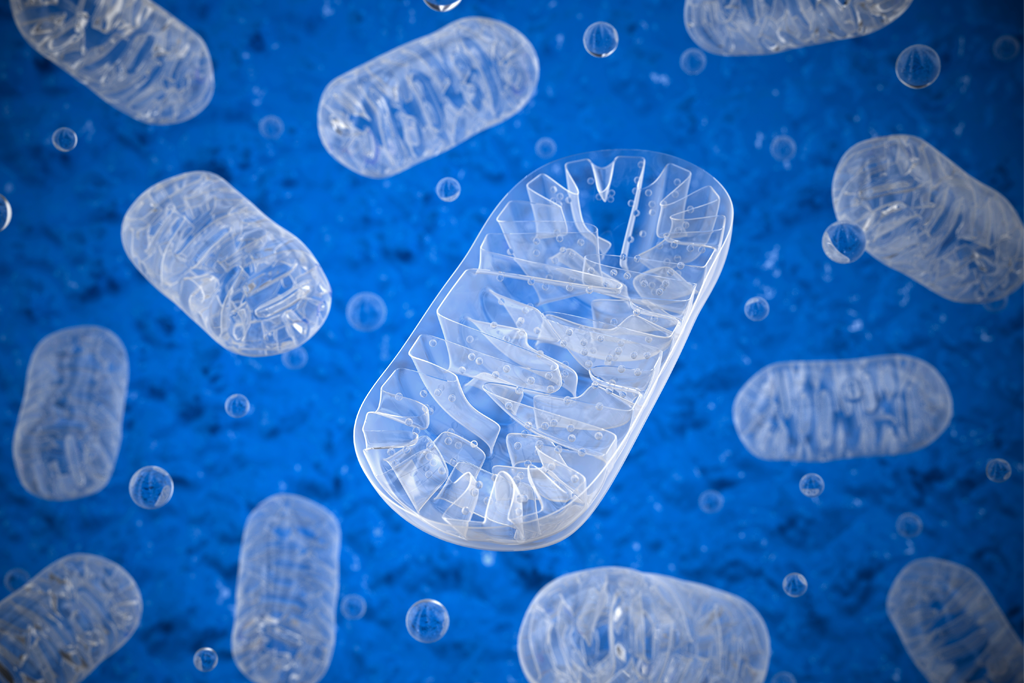ARTICLE
What are Mitochondria, and Why Do They Matter?

Every living thing is comprised of cells, which are the building blocks of life. Inside of these cells are a series of organelles – sub-compartment-like entities that perform various but specific functions. Different cells throughout your body notably have different shapes and sizes, and thus, different purposes. Similar cells (ones that do the same job) form body tissues, such as muscle, skin, or bone tissue. Groups of different types of cells make up the organs in your body, such as your heart, liver, or lungs. Collectively, all organs work together as a system to keep you alive and healthy (Science NetLinks).
What are mitochondria?
“The powerhouse of the cell” — that’s how most people think of and remember the mitochondrion (plural: mitochondria) from their high school biology class. They are organelles that function like microscopic, yet super complex factories, producing energy and disposing of waste that is detrimental to the body. Mitochondria are critical for cell survival, and ATP (energy) that your mitrochondria help produce is vital for metabolic processes and keeping you healthy.
The Structure of Mitochondria
Mitochondria are designed to maximize their productivity. They contain two membranes – the outer membrane functions like a skin, and the inner membrane makes it possible for more reactions to occur. This means that your cells can get more work done. Outer membrane: This is a phospholipid bilayer that includes protein-based structures called porins, which enable molecules (ions, ATP, ADP, etc.) to cross.
Inner membrane: This membrane is highly complex and it is where most ATP is created. It includes all the complexes of the electron transport system, the ATP synthetase complex, and transport proteins. The inner membrane does not have porins like the outer membrane, so it is impermeable to most molecules.
Cristae: These are the folds of the inner membrane, which increase the surface area and the space available for chemical reactions to occur. This is also where the electron transport chain and enzymes are located. The number of cristae in the mitochondria correlates with the given cell’s demand for ATP. For example, heart muscle cells contain up to three times more cristae than other cells due to the greater need for ATP (Biology Dictionary).
Matrix: This is the space within the inner membrane where the citric acid cycle, or Krebs cycle, takes place. This is an important part of cellular respiration and ATP production. Mitochondrial DNA is also housed here.
How the Mighty Mitochondria Work
Mitochondria are found in the cells of animals, humans, plants and fungi. While they are primarily known for converting energy from food to energy for biological processes, mitochondria are deeply involved in several other activities that enable cells to function efficiently to help you keep your body healthy. Here are the five key roles that mitochondria play in cellular health, and what can happen when these functions are disturbed:
- Production of ATP – Mitochondria produce 90% of the energy our body needs to function by converting chemical energy from nutrients to ATP. During cellular respiration, another chemical called NADH is produced, which is then used by enzymes to generate ATP in the form of chemical bonds. The production of ATP is essential to help the body function properly. Without energy, your cells and your body suffer. Dysfunction from lack of ATP can contribute to a variety of health concerns, including but not limited to: Alzheimer’s, Parkinson’s, Lou Gehrig’s disease, diabetes, cancer, and several types of mitochondrial disease.
- Calcium Homeostasis — This is the flow of calcium in and out of a cell’s mitochondria. This process is an important part of metabolic regulation and killing off unhealthy cells. When mitochondrial calcium homeostasis is compromised, different pathological conditions can occur, depending on the cell type involved (NCBI).
- Cell Migration — This refers to the orchestrated movement of cells to specific locations in response to chemical signals. Regulation of cell migration can help terminate unhealthy cells and speed up wound-healing; conversely, if this process is not well-managed, there may be serious health consequences, including but not limited to: tumor formation and cancer formation, vascular disease, tumor formation and metastasis.
- Apoptosis – This is essentially programmed cell death which involves maintaining the health of the body by eliminating old cells, unnecessary cells, and unhealthy cells. Without appropriate apoptosis (either too little or too much), there is a greater risk of experiencing health conditions, including neurodegenerative diseases, ischemic damage, autoimmune disorders and many types of cancer (NCBI).
- Innate Immunity — This refers to nonspecific defense mechanisms – such as skin, chemicals in the blood, and cells within your immune system that attack foreign cells — that basically come to the rescue immediately or within hours of an antigen’s appearance in the body. In addition to regulating antiviral signaling, mitochondria also contribute to innate immune activation following cellular damage and stress (NCBI).
To recap, ATP is energy currency for your cells, and your mitochondria are the primary sources for producing more of it to help keep you alive and healthy. These organelles are also responsible for surveilling and eliminating the growth of unhealthy cells. If any deficiency in your mitochondria are present, then you are more likely to experience health issues.
